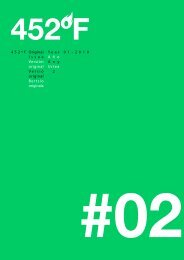03 - 452ºF
03 - 452ºF
03 - 452ºF
Create successful ePaper yourself
Turn your PDF publications into a flip-book with our unique Google optimized e-Paper software.
a result, according to Chick Lit Books, chick lit novels are no longer<br />
«excessively light, airy and frilly» (n.d.: par. 7), and the typically<br />
fluorescent pink book covers are, in fact, «truly masking meaningful,<br />
touching, hilarious at times and wonderful chick lit stories» (n.d.: par.<br />
9).<br />
2. Chick lit in the nineteenth century: where did it all<br />
begin?<br />
For a genre whose success has taken the world by storm in a<br />
relatively short space of time, and one which has caused as much<br />
controversy as it has earned praise, there are some discrepancies<br />
over how the genre actually began.<br />
In discussing the beginnings of chick lit, many agree that the genre<br />
began with Helen Fielding’s 1996 novel, Bridget Jones’s Diary – it has<br />
been stated that the «entire chick-lit phenomenon is invariably traced<br />
back to this single novel» (Ferriss, 2006: 4). However, while Bridget<br />
Jones’s Diary came to be viewed by many as the original chick lit<br />
text, «there were precursors which demonstrated that Fielding had<br />
merely tapped a nerve with her own writing which already existed»<br />
(Whelehan, 2005: 191). So, how can we trace the roots of chick lit?<br />
Many people argue that the entire genre «proves to be indebted to<br />
women’s literature of the past» (Ferriss, 2006: 5), most notably the<br />
work of Austen, who has been described as «surely the mother of<br />
all chick lit» (Mlynowski, 2006: 11). Aside from the much-discussed<br />
connection between Bridget Jones’s Diary and Pride and Prejudice,<br />
«from which Fielding admittedly borrowed much of her plot and<br />
many of her characters» (Ferriss, 2006: 4), we can see numerous<br />
similarities between modern chick lit novels and fiction by the likes<br />
of Austen and the Brontës, whose work included «all the romance,<br />
negotiations of society and character growth that we see in many of<br />
the popular “chick lit” novels today» (Dawson, n.d.: par. 3). In this<br />
sense, it would certainly seem viable to argue that chick lit does «have<br />
identifiable roots in the history of women’s writing, as do many of<br />
the genre’s characteristic elements: the heroine’s search for an ideal<br />
romantic partner; her maturation and growth in self-knowledge, often<br />
aided by friends and mentors; and her relationship to conventions of<br />
beauty» (Wells, 2006: 49), as well as a focus on issues of relevance<br />
to women’s lives and interests, such as careers and body image.<br />
Hence we can see that the romantic element of the novels is not<br />
the only characteristic common to nineteenth century novels and<br />
today’s chick lit, although the heroine eventually falling in love with<br />
an initially unlikely hero is certainly a major theme in both. Modern<br />
Trivial or Commendable? : Women’s Writing, Popular Culture, and Chick Lit - Mary Ryan<br />
<strong>452ºF</strong>. #<strong>03</strong> (2010) 70-84.<br />
76










